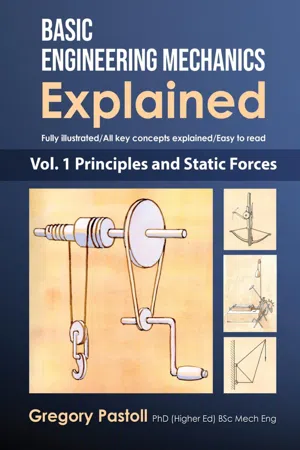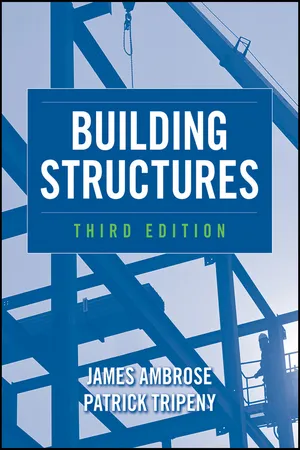Technology & Engineering
Zero Force Members
Zero force members are structural elements within a truss that carry no force when the entire truss is in equilibrium. These members can be identified by analyzing the geometry and load distribution of the truss. They play a crucial role in simplifying the analysis of truss structures, as they can be removed without affecting the overall stability of the truss.
Written by Perlego with AI-assistance
Related key terms
Related key terms
1 of 4
Related key terms
1 of 3
3 Key excerpts on "Zero Force Members"
- eBook - ePub
Basic Engineering Mechanics Explained, Volume 1
Principles and Static Forces
- Gregory Pastoll, Gregory Pastoll(Authors)
- 2019(Publication Date)
- Gregory Pastoll(Publisher)
some load.It is not always easy to detect by inspection which members might be no-load members. For instance, in this simple wall-crane, member 1 - 4 appears to be a strut, for, if it were to be removed, node 4 might be expected to move closer to node 1.However, as will be seen from the analysis of this truss further on, member 1 - 4 is actually a ‘no-load’ member in this arrangement, under the given external loading. This simply means that with the given loading, the other members appear to be stable without the inclusion of member 1 - 4.Three methods of determining the forces in the individual members of a pin-jointed truss.The first step is always to determine the values of all the external forces (including the reactions at the supports) acting on the truss. Once this has been done, any of the following three methods can be used. These methods are all explained, in detail, in the pages that follow.1. Considering the equilibrium of each node . Draw a FBD of each pin, assume the pin is in equilibrium, and solve for the unknown forces that the adjacent members must be exerting on that pin, using the equations for the equilibrium of the pin, namely ΣFx = 0 and ΣFy = 0.2. The ‘method of sections’ , in which imaginary cuts or ‘sections’ are made through the truss at selected positions. The portion of the truss on one side of the ‘section’ can be regarded as a flat plate in equilibrium. This allows the equations ΣFx = 0 ; ΣFy = 0 and Σ Mo - eBook - ePub
- James Ambrose, Patrick Tripeny(Authors)
- 2011(Publication Date)
- Wiley(Publisher)
In structural design the typical force analysis problem begins with the assumption that the net effect is one of static equilibrium. Therefore, if some forces in a system are known (e.g., the loads on a structure), and some are unknown (e.g., the forces generated in members of the structure in resisting loads), the determination of the unknown forces consists of finding out what is required to keep the whole system in equilibrium. The relationships and procedures that can be utilized for such analyses depend on the geometry or arrangement of the forces.For a simple concentric, coplanar force system, the conditions necessary for static equilibrium can be stated as follows:In other words, if both components of the resultant are zero, the resultant is zero and the system is in equilibrium. In a graphic solution the resultant will be zero if the force polygon closes on itself, that is, if the head of the last force vector coincides with the tail of the first force vector.Although a basic concept of statics is that no motion occurs, it is often helpful in investigation of forces to consider the potential motion that is impending due to the effect of a force. This is especially true when considering the necessary requirements for maintaining equilibrium of a structure.Analysis of Coplanar, Concurrent ForcesThe forces that operate on individual joints in planar trusses constitute sets of coplanar, concurrent forces. The following discussion deals with the analysis of such systems, both graphically and algebraically, and introduces some of the procedures that will be used in the examples of truss analysis in this book.In the preceding examples, forces have been identified as F 1 , F 2 , F 3 , and so on. However, a different system of notation (Bow's notation) will be used in the work that follows. This method consists of placing a letter in each space that occurs between the forces or their lines of action, each force then being identified by the two letters that appear in the adjacent spaces. A set of five forces is shown in Figure 2.11 a . The common intersection point is identified as BCGFE and the forces are BC, CG, GF, FE, and EB. - eBook - ePub
Design-Tech
Building Science for Architects
- Thomas Leslie, Robert Whitehead(Authors)
- 2014(Publication Date)
- Routledge(Publisher)
qualities, but they represent important three-dimensional behaviors for how forces flow through a structural system. The manner is which forces work their way through a system is inextricably linked with its manner of construction and arrangement of components. Even though structures are interconnected, engineers often divide up the design of the system into a series of smaller elements that can be solved in relation to each other. This finite element analysis approach allows engineers to design each component in the system based upon the anticipated loads. In order to achieve this analysis, loading conditions throughout the structure need to be established and quantified. Next, one has to know the length of each component's span and its frequency of spacing in order to find the tributary area for what is being supported by each component. This information is then represented two-dimensionally (using the types of loading examples shown above) to solve for support conditions and internal forces within each component to create a state of equilibrium. Even though buildings are supported from the ground up, analyzing the way forces move through the system starts at the top and works its way downward. Typically loads are transferred from the smallest members that are spanning modest distances, such as the roof/floor decking that spans between joists, to the progressively larger, stronger, set of components, such as the beams that carry the joists and span between columns. Forces are transferred, consolidated and accumulated throughout the structure until their eventual transfer into the foundation. Note that in the Figure 20.9, examples of both distributed and concentrated loads are shown. Interestingly, even though the joists that hold up the roof are acting as concentrated loads upon the beam below, they essentially are imparting an equally distributed load along the length of the beam
Index pages curate the most relevant extracts from our library of academic textbooks. They’ve been created using an in-house natural language model (NLM), each adding context and meaning to key research topics.
Explore more topic indexes
Explore more topic indexes
1 of 6
Explore more topic indexes
1 of 4


